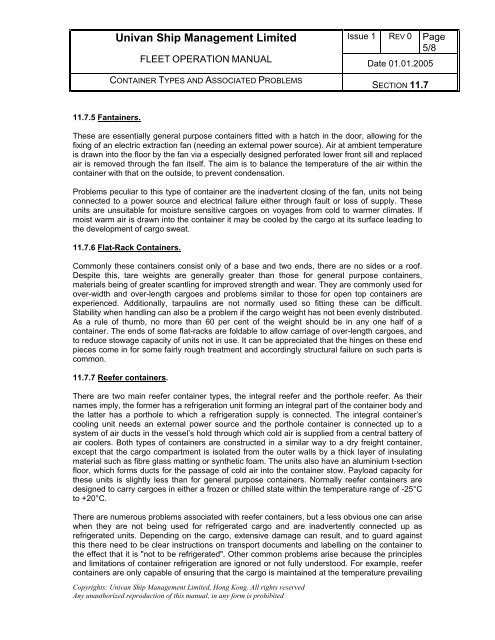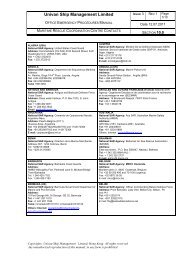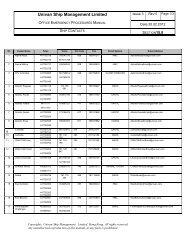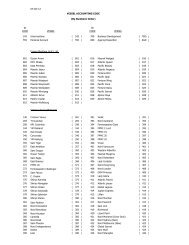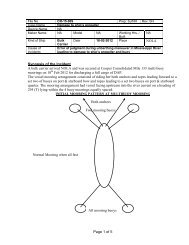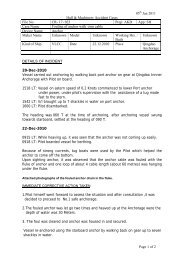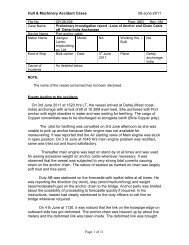Section: 11 CARGO OPERATIONS - Univan
Section: 11 CARGO OPERATIONS - Univan
Section: 11 CARGO OPERATIONS - Univan
Create successful ePaper yourself
Turn your PDF publications into a flip-book with our unique Google optimized e-Paper software.
<strong>11</strong>.7.5 Fantainers.<br />
<strong>Univan</strong> Ship Management Limited Issue 1 REV 0 Page<br />
5/8<br />
FLEET OPERATION MANUAL Date 01.01.2005<br />
CONTAINER TYPES AND ASSOCIATED PROBLEMS<br />
Copyrights: <strong>Univan</strong> Ship Management Limited, Hong Kong. All rights reserved<br />
Any unauthorized reproduction of this manual, in any form is prohibited<br />
SECTION <strong>11</strong>.7<br />
These are essentially general purpose containers fitted with a hatch in the door, allowing for the<br />
fixing of an electric extraction fan (needing an external power source). Air at ambient temperature<br />
is drawn into the floor by the fan via a especially designed perforated lower front sill and replaced<br />
air is removed through the fan itself. The aim is to balance the temperature of the air within the<br />
container with that on the outside, to prevent condensation.<br />
Problems peculiar to this type of container are the inadvertent closing of the fan, units not being<br />
connected to a power source and electrical failure either through fault or loss of supply. These<br />
units are unsuitable for moisture sensitive cargoes on voyages from cold to warmer climates. If<br />
moist warm air is drawn into the container it may be cooled by the cargo at its surface leading to<br />
the development of cargo sweat.<br />
<strong>11</strong>.7.6 Flat-Rack Containers.<br />
Commonly these containers consist only of a base and two ends, there are no sides or a roof.<br />
Despite this, tare weights are generally greater than those for general purpose containers,<br />
materials being of greater scantling for improved strength and wear. They are commonly used for<br />
over-width and over-length cargoes and problems similar to those for open top containers are<br />
experienced. Additionally, tarpaulins are not normally used so fitting these can be difficult.<br />
Stability when handling can also be a problem if the cargo weight has not been evenly distributed.<br />
As a rule of thumb, no more than 60 per cent of the weight should be in any one half of a<br />
container. The ends of some flat-racks are foldable to allow carriage of over-length cargoes, and<br />
to reduce stowage capacity of units not in use. It can be appreciated that the hinges on these end<br />
pieces come in for some fairly rough treatment and accordingly structural failure on such parts is<br />
common.<br />
<strong>11</strong>.7.7 Reefer containers.<br />
There are two main reefer container types, the integral reefer and the porthole reefer. As their<br />
names imply, the former has a refrigeration unit forming an integral part of the container body and<br />
the latter has a porthole to which a refrigeration supply is connected. The integral container’s<br />
cooling unit needs an external power source and the porthole container is connected up to a<br />
system of air ducts in the vessel’s hold through which cold air is supplied from a central battery of<br />
air coolers. Both types of containers are constructed in a similar way to a dry freight container,<br />
except that the cargo compartment is isolated from the outer walls by a thick layer of insulating<br />
material such as fibre glass matting or synthetic foam. The units also have an aluminium t-section<br />
floor, which forms ducts for the passage of cold air into the container stow. Payload capacity for<br />
these units is slightly less than for general purpose containers. Normally reefer containers are<br />
designed to carry cargoes in either a frozen or chilled state within the temperature range of -25°C<br />
to +20°C.<br />
There are numerous problems associated with reefer containers, but a less obvious one can arise<br />
when they are not being used for refrigerated cargo and are inadvertently connected up as<br />
refrigerated units. Depending on the cargo, extensive damage can result, and to guard against<br />
this there need to be clear instructions on transport documents and labelling on the container to<br />
the effect that it is "not to be refrigerated". Other common problems arise because the principles<br />
and limitations of container refrigeration are ignored or not fully understood. For example, reefer<br />
containers are only capable of ensuring that the cargo is maintained at the temperature prevailing


